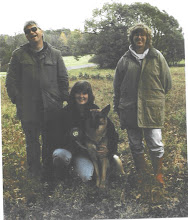In all areas of life, having a plan makes success more likely. Tracking is no exception. This is a sport of endless variables, so once you learn how to develop a tracking plan for the day, you will have no issues with this concept. A few of the variables to consider are:
- Track age
- Topography - hills, ditches, mowed paths
- Cover - length, changes in, variety of
- Weather - rain, drizzle, dry, humidity, heat, cold
- Wind direction - into, away from, across
- Articles - indication, type, placement
- Starts - angle of, direction of, your behavior at
- Corners - obtuse, 90 degree, all directions, on, across and at hills, changes of cover, etc.
- "Dumb handler" exercises - "immunizing" your dog against fumbling, bumbling and error
- Distractions - people following, people talking, other animals near by
- Crosstracks of all sorts - "dirty" fields.
- Losing the track
- Working blind tracks
The list goes on. When I asked Melissa to list all the variables she could think of for TD work, she came up with over fifty. I'd call that a good beginning.
When contemplating your plan of action keep this in mind: Most AKC teams fail at the start or the first turn. So what is my favorite sort of tracking workout? Stacked "L's" Meaning I lay three shorter tracks, each one presenting a different puzzle or exercise to the dog. If I am working hill starts, I'll might lay one "L" starting up hill, the next starting down and the last across.
This is also why keeping a list of your maps is critical. That is the only way you can "check your work" and see if you really have worked everything you wanted to prior to a test.
Getting in the habit of developing a plan each and every time you enter the fields is one of the ways to ensure success.






No comments:
Post a Comment